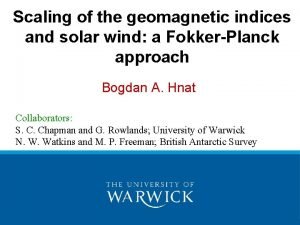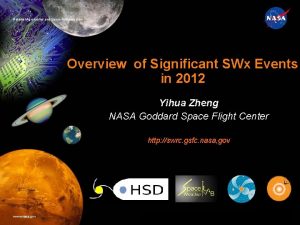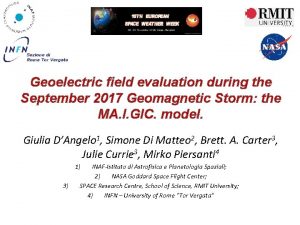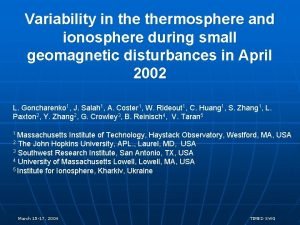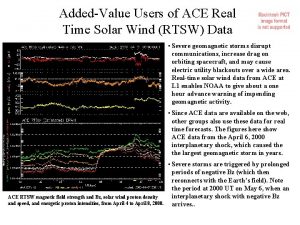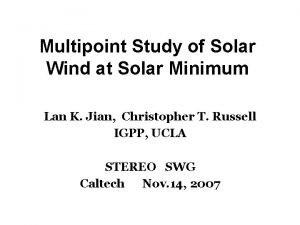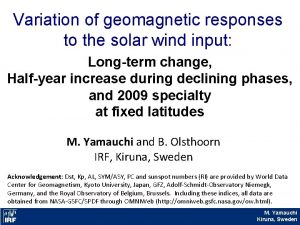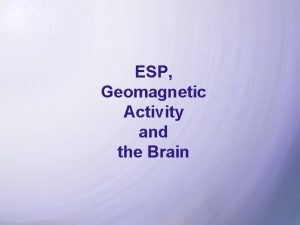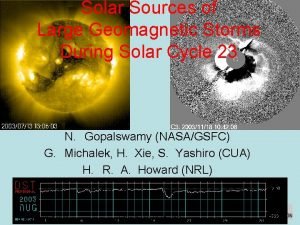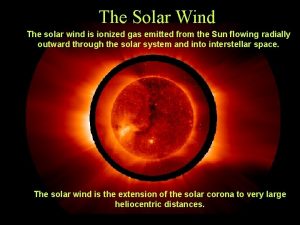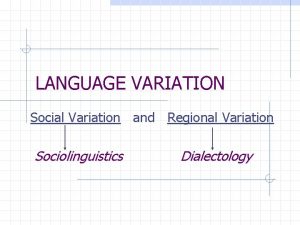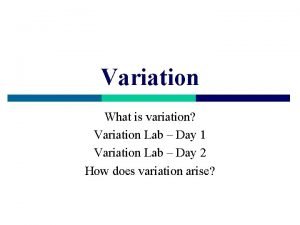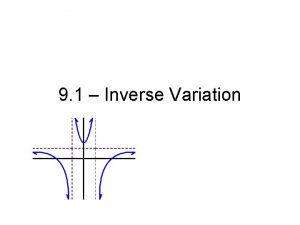Variation of geomagnetic responses to the solar wind














- Slides: 14

Variation of geomagnetic responses to the solar wind input in long term M. Yamauchi, B. Olsthoorn Acknowledgement: Dst, Kp, AL, SYM/ASY, PC and sunspot numbers (RI) are provided by World Data Center for Geomagnetism, Kyoto University, Japan, GFZ, Adolf-Schmidt-Observatory Niemegk, Germany, and the Royal Observatory of Belgium, Brussels. Including these indices, all data are obtained from NASAGSFC/SPDF through OMNIWeb (http: //omniweb. gsfc. nasa. gov/ow. html). 1

Purpose (motivation) Geomagnetic disturbance for the same solar wind input (we call Sun-Earth coupling efficiency): - It has been assumed constant. Is it really constant? - If it varies, is it due to EUV, location of aurora, or other reason? Method • For diagnosis, we first examine indices (AE, PC, SYM/ASY) which have high resolution data. • Must remove seasonal variation ⇒ 3 -months resolution to separate "equinox" & solstice • Use 5 -min NASA/OMNI data for solar wind condition ⇒ Then calculate coupling functions, e. g. , ' = (4π/µ 0)·VBtan 2 sin 4( C/2), dΦ/dt = (V 2 SW·Btan·sin 4(θc/2))2/3 • Travel time from the spacecraft to the Earth is introduced. • Estimate “integrated input” for 5 -60 min before ⇒ we averaged these coupling functions over 5 -60 min ⇒ the correlation is best for 60 min average) 2

Result / overview of "response" (1) within a solar cycle: 1 -year enhancement during declining phase? (2) longer scale: decreasing trend with 2009 minimum? 3

Result / overview (why we take equinox) same result for dΦ/dt as ' solstice: more AE/SYM stations in the northern hemisphere 4

The singular period does not match with the declining phase peak of solar wind input 5

Phase difference • divide into 4 phases ’ dΦ/dt • take relative values against average Result: outstanding < moderate activities (not storms!) 6

How about different latitude? Result: PC/AU are similar SYM-H is unclear, ASY-D not at all 7

Long-term (cycle-to-cycle) trend ’ dΦ/dt • divide into different cylcles (#21 and #24 are not complete, though) • take relative values against average Result: decreasing trend over 4 cycles 8

How about different latitudes? Result: AU/SYM-H are similar PC only clycle #24, ASY-D not at all 9

Same for longer time series (but hourly value) Result: smaller during 2005 -2014 (x ~ cycle #24) than before (Yamauchi, 2015) 10

due to shift of quiet-time aurora?

Summary (1) For quiet to moderate solar wind input (corresponding to |AL| < 400 n. T activity on average), the AL, AU, and PC responses to the same input values increased much beyond the fluctuation level for about 3 -12 months during 1983, 1994, 2003, and 2016, all during the early declining phase of solar cycles. Some increase for SYM-H, but non at all for ASY-D (enhance rather post-maximum) ⇓ (2) Except during these periods, AL and AU responses to the same range of solar wind input continuously decreased at least until 2009. The first result can be attributed to equatorward shift of the quiet-time polar cap boundary during the singular periods. Possible future work: same analyses using IMAGE midnight data? identify auroral location? 12

Overview for higher latitude? 13

Overview for lower latitude? 14
 Building statistics
Building statistics Geomagnetic
Geomagnetic Geomagnetic
Geomagnetic Geomagnetic
Geomagnetic Direct and inverse variation
Direct and inverse variation Prediction interval formula
Prediction interval formula Constant of variation
Constant of variation Raumschotkurs
Raumschotkurs Ace rtsw
Ace rtsw Wind energy is an indirect form of solar energy
Wind energy is an indirect form of solar energy Solar wind
Solar wind What is an inexhaustible source of energy
What is an inexhaustible source of energy Wholesale solar panel battery
Wholesale solar panel battery Quá trình desamine hóa có thể tạo ra
Quá trình desamine hóa có thể tạo ra Phản ứng thế ankan
Phản ứng thế ankan
